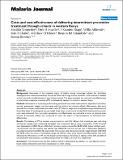| dc.contributor.author | Temperley, Matilda | en_US |
| dc.contributor.author | Mueller, Dirk H | en_US |
| dc.contributor.author | Njagi, J Kiambo | en_US |
| dc.contributor.author | Akhwale, Willis | en_US |
| dc.contributor.author | Clarke, Siân E | en_US |
| dc.contributor.author | Jukes, Matthew | en_US |
| dc.contributor.author | Estambale, Benson BA | en_US |
| dc.contributor.author | Brooker, Simon | en_US |
| dc.date.accessioned | 2010-11-10T18:21:08Z | |
| dc.date.issued | 2008 | en_US |
| dc.identifier.citation | Temperley, Matilda, Dirk H Mueller, J Kiambo Njagi, Willis Akhwale, Siân E Clarke, Matthew CH Jukes, Benson BA Estambale, and Simon Brooker. 2008. Costs and cost-effectiveness of delivering intermittent preventive treatment through schools in western Kenya. Malaria Journal 7: 196. | en |
| dc.identifier.issn | 1475-2875 | en |
| dc.identifier.uri | http://nrs.harvard.edu/urn-3:HUL.InstRepos:4553284 | |
| dc.description.abstract | Background Awareness of the potential impact of malaria among school-age children has stimulated investigation into malaria interventions that can be delivered through schools. However, little evidence is available on the costs and cost-effectiveness of intervention options. This paper evaluates the costs and cost-effectiveness of intermittent preventive treatment (IPT) as delivered by teachers in schools in western Kenya.Methods Information on actual drug and non-drug associated costs were collected from expenditure and salary records, government budgets and interviews with key district and national officials. Effectiveness data were derived from a cluster-randomised-controlled trial of IPT where a single dose of sulphadoxine-pyrimethamine and three daily doses of amodiaquine were provided three times in year (once termly). Both financial and economic costs were estimated from a provider perspective, and effectiveness was estimated in terms of anaemia cases averted. A sensitivity analysis was conducted to assess the impact of key assumptions on estimated cost-effectiveness.Results The delivery of IPT by teachers was estimated to cost US$ 1.88 per child treated per year, with drug and teacher training costs constituting the largest cost components. Set-up costs accounted for 13.2% of overall costs (equivalent to US$ 0.25 per child) whilst recurrent costs accounted for 86.8% (US$ 1.63 per child per year). The estimated cost per anaemia case averted was US$ 29.84 and the cost per case of Plasmodium falciparum parasitaemia averted was US$ 5.36, respectively. The cost per case of anaemia averted ranged between US$ 24.60 and 40.32 when the prices of antimalarial drugs and delivery costs were varied. Cost-effectiveness was most influenced by effectiveness of IPT and the background prevalence of anaemia. In settings where 30% and 50% of schoolchildren were anaemic, cost-effectiveness ratios were US$ 12.53 and 7.52, respectively.Conclusion This study provides the first evidence that IPT administered by teachers is a cost-effective school-based malaria intervention and merits investigation in other settings. | en |
| dc.language.iso | en_US | en |
| dc.publisher | BioMed Central | en |
| dc.relation.isversionof | doi://10.1186/1475-2875-7-196 | en |
| dc.relation.hasversion | http://www.ncbi.nlm.nih.gov/pmc/articles/PMC2564968/pdf/ | en |
| dash.license | OAP | en_US |
| dc.title | Costs and cost-effectiveness of delivering intermittent preventive treatment through schools in western Kenya | en |
| dc.type | Journal Article | en_US |
| dc.relation.journal | Malaria Journal | en |
| dash.depositing.author | Jukes, Matthew | en_US |
| dc.date.available | 2010-11-10T18:21:08Z | |
| dc.identifier.doi | 10.1186/1475-2875-7-196 | * |
| dash.contributor.affiliated | Jukes, Matthew | |
| dc.identifier.orcid | 0000-0001-6001-041X | |


